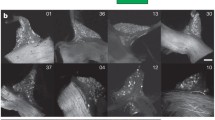Abstract
The sense of taste, although a relatively undistinguished sensory modality in most mammals, is a highly developed sense in many fishes, e.g., catfish, gadids, and carps including goldfish. In these species, the amount of neural tissue devoted to this modality may approach 20% of the entire brain mass, reflecting an enormous number of taste buds scattered across the external surface of the animal as well as within the oral cavity. The primary sensory nuclei for taste form a longitudinal column of nuclei along the dorsomedial surface of the medulla. Within this column of gustatory nuclei, the sensory system is represented as a fine-grain somatotopic map, with external body parts being represented rostrally within the column, and oropharyngeal surfaces being represented caudally. Goldfish have a specialization of the oral cavity, the palatal organ, which enables them to sort food particles from particulate substrate material such as gravel. The palatal organ taste information reaches the large, vagal lobe with a complex laminar and columnar organization. This lobe also supports a radially-organized reflex system which activates the musculature of the palatal organ to effect the sorting operation. The stereotyped, laminated structure of this system in goldfish has facilitated studies of the circuitry and neurotransmitter systems underlying the goldfish’s ability to sort food from stones.







Similar content being viewed by others
References
Ariens Kappers CUA, Huber GC, Crosby EC (1936) The comparative anatomy of the nervous system of vertebrates, including man. Macmillan, New York
Barlow LA, Northcutt RG (1995) Embryonic origin of amphibian taste buds. Dev Biol 169:273–285
Bullock TH, Horridge GA (1965) Structure and function in the nervous systems of invertebrates. Freeman, San Francisco
Callan WT, Sanderson SL (2003) Feeding mechanisms in carp: crossflow filtration, palatal protrusions and flow reversals. J Exp Biol 206:883–892
Finger TE, Bullock TH (1982) Thalamic center for the lateral line system in the catfish, Ictalurus nebulosus: evoked potential evidence. J Neurobiol 13:39–47
Finger TE, Dunwiddie TV (1992) Evoked responses from an in vitro slice preparation of a primary gustatory nucleus: the vagal lobe of goldfish. Brain Res 580:27–34
Goehler LE, Finger TE (1992) Functional organization of vagal reflex systems in the brain stem of the goldfish, Carassius auratus. J Comp Neurol 319:463–478
Herrick CJ (1922) An introduction to neurology. W.B. Saunders, Philadelphia
Ikenaga T, Ogura T, Finger TE (2007) Neurotransmitters in brainstem gustatory reflex circuitry. Chem Senses 32:A44
Kanwal JS, Caprio J (1988) Overlapping taste and tactile maps of the oropharynx in the vagal lobe of the channel catfish, Ictalurus punctatus. J Neurobiol 19:211–222
Konishi J, Zotterman Y (1961) Taste functions in the carp: an electrophysiological study on gustatory fibres. Act Physiol Scand 52:150–161
Kotrschal K, Palzenberger M (1992) Neuroecology of cyprinids: comparative, quantitative histology reveals diverse brain patterns. Environ Biol Fishes 33:135–152
Kruger L (2004) An early illustrated comparative anatomy of the brain: Samuel Collins’ A Systeme of Anatomy (1685) and the emergence of comparative neurology in 17th century England. J Hist Neurosci 13:195–217
Lamb CF, Finger TE (1995) Gustatory control of feeding behavior in goldfish. Physiol Behav 57:483–488
Morita Y, Finger TE (1985) Topographic and laminar organization of the vagal gustatory system in the goldfish, Carassius auratus. J Comp Neurol 238:187–201
Morita Y, Ito H, Masai H (1980) Central gustatory paths in the crucian carp, Carassius carassius. J Comp Neurol 19:119–132
Sanderson SL, Cheer AY, Goodrich JS, Graziano JD, Callan WT (2001) Crossflow filtration in suspension-feeding fishes. Nature 412:439–441
Sibbing FA, Uribe R (1985) Regional specializations in the oropharyngeal wall and food processing in the carp (Cyprinus carpio L.). Neth J Zool 35:377–422
Sibbing FA, Osse JMW, Terlouw A (1986) Food handling in the carp (Cyrinus carpio): its movement patterns, mechanisms, and limitations. J Zool 210:161–203
Smeraski CA, Dunwiddie TV, Diao L, Finger TE (1999) NMDA and non-NMDA receptors mediate responses in the primary gustatory nucleus in goldfish. Chem Senses 24:37–46
Stone LM, Finger TE, Tam PP, Tan SS (1995) Taste receptor cells arise from local epithelium, not neurogenic ectoderm. Proc Natl Acad Sci USA 92:1916–1920
Acknowledgments
The author thanks the many collaborators and colleagues whose studies contributed to understanding the vagal lobe. Several of the summary diagrams in this work were adapted from work of Takanori Ikenaga. The experiments described herein comply with the “Principles of animal care”, publication No. 86-23, revised 1985 of the National Institute of Health, and were approved by the University of Colorado Health Sciences Center Institutional of Animal Care and Use Committee.
Author information
Authors and Affiliations
Corresponding author
Rights and permissions
About this article
Cite this article
Finger, T.E. Sorting food from stones: the vagal taste system in Goldfish, Carassius auratus . J Comp Physiol A 194, 135–143 (2008). https://doi.org/10.1007/s00359-007-0276-0
Received:
Revised:
Accepted:
Published:
Issue Date:
DOI: https://doi.org/10.1007/s00359-007-0276-0




